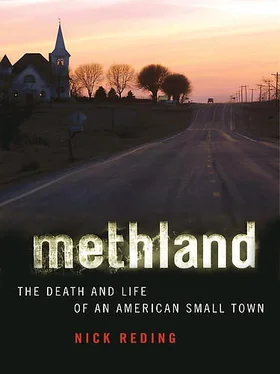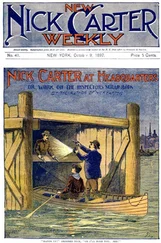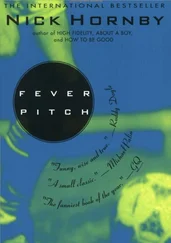Murph understood, perhaps more than anyone, the manner in which Oelwein’s financial difficulties of the last two decades reinforced its meth problem. His job was increasingly directed by the belief that in solving the town’s economic dilemma, the drug problem, too, would abate. That was the hope, anyway. On another level, meth seemed to operate completely outside the bounds of any rational, calculated variables. If crank was supposed to appeal only to people with nothing to lose, why then, said Murph, did the “good families” suffer its consequences, too? Recently, the husband of the woman who owned a local beauty salon had been hallucinating so badly one night that he accused his wife of having sex with a stranger in the bed next to him (she was hiding with her daughter in an adjoining room at the time), and then he tried to kill her. It was as though, said Murph, a sense of nihilism had become endemic to Oelwein.
One example of the connection between financial loss and the increase in meth use was a feeling among the small-time cooks that they, like the moonshiners of the early twentieth century, were the last of a breed, not just of rebellious criminals, but of small-business people. In the wake of so many closed storefronts, it was the Beavis and Butt-Head cooks, as the police called them, who touted their place as entrepeneurs in the increasingly weak economy of Oelwein. It was an added benefit of the vitality of their businesses that people, when they snorted or smoked local crank, felt good for days. Viewing themselves as modern-day Pied Pipers, the cooks by their very presence in town posed a question to which the answer was not obvious: What else was there to feel good about? It was a logic that had become pervasive. Across the street from Nathan Lein’s house, ninety feet from his front door, a married couple who were batchers worked day and night until Nathan tried and convicted them in 2003.
Small-time cooks in Oelwein make a kind of methamphetamine called “Nazi cold,” which relies on anhydrous ammonia, a chemical fertilizer rich in nitrate that farmers spray on their fields, and pseudoephedrine rendered from Sudafed and Contac. The name Nazi cold refers in part to the dependence on cold medicine and in part to the methamphetamine synthesis process used by the Germans in World War II, which depended on nitrate. Of the latter ingredient, the Germans had enormous supplies, for nitrate is also a key component in gunpowder. (With enough gunpowder and enough meth, one might conclude, anything seems possible.) German meth-amphetamine during the war, manufactured by the pharmaceutical companies Temmler and Knoll and sold under the name Pervitin, was in fact made in laboratories, and in huge quantities: millions of pills each month.
Nazi cold meth, on the other hand, can be manufactured wherever, and in quantities that rarely exceed a pound per cook, but which are more likely to produce only a few grams of what is locally called swag, shit, batch, and crank. Lab locations in Iowa in the past decade have included bait and tackle shops, river barges, networks of tunnels dug with backhoes, the cab of a combine, thousands of kitchen sinks, bathtubs, and motel rooms, a high school locker room, and a retirement home, in which the elderly residents were given excessive doses of opiates so that they would not wake up while the batchers worked. In one Iowa county, the school district banned bake sales after several children unwittingly brought to school meth-tainted chocolate chip cookies and Rice Krispies treats that sickened classmates.
Like dioxin, meth residue possesses a unique ability to bind to food, countertops, microwave walls, sink basins, and human lung tissue for days after being synthesized. Making the drug is a dangerous undertaking. The extreme “heat” of anhydrous ammonia, which is stored at negative two hundred degrees Fahrenheit, is such that it can burn through human tissue to the bone. By 2005, meth-making in Oelwein was a process more often completed in a twenty-ounce soda bottle than in an actual laboratory. At least one step in the process—adding lithium to anhydrous—can result in explosive boiling if not properly done. In another method of production, adding blue iodine to red phosphorus often produces phosphine gas, which is toxic enough to cauterize lung and throat tissue. The side effects of meth—bleeding skin-sores as your pores struggle to open and expel the drug, which often become infected; internal organs shrunken from dehydration; vast areas of the brain that according to CAT scans are completely depleted of neurotransmitters: a sense that a person is literally falling apart from the inside out—seem almost unnatural, something visited upon our waking lives from the unconscious. The cruel irony is that it is a horror completely of our own making.
“Lab,” then, is largely a misnomer. All that is truly necessary to make Nazi dope, in addition to the anhydrous ammonia and the cold pills, is a lithium strip from inside a battery (accessible by unrolling the layers of zinc and aluminum that lie beneath the protective sheath), some Coleman lantern fluid, and a ninth-grade knowledge of chemistry. Using a soda bottle instead of a pair of buckets rigged with surgical tubing is called the single-batch system, and it became popular in Oelwein once the police had begun raiding so many homes in search of meth labs. Single-batching was devised as a way to cook while riding mountain bikes. If they strapped a soda bottle onto a rack over the rear wheel, single-batchers believed that the constant movement—unlike in a home lab—would diffuse the smell of the process. They further believed that the police wouldn’t suspect people on bikes of cooking meth. (It didn’t take long to catch on. In one story, a Fayette County sheriff’s deputy pulls up to a kid sitting by the side of the road amid a wilderness of midsummer corn. His bike in pieces all around him, he has a soda bottle at his side, inside of which there is a small inferno of activity: he has decided, while he waits for his meth to cook, to take his bike completely apart and put it back together again. The boy asks the deputy why he stopped. “I got a call,” says the deputy, in the bone-dry wit endemic to the Midwest, “that you needed to borrow a screwdriver.”)
The first order of business for any Nazi cold cook is to amass quantities of cold pills. To do this, cooks generally hire people who will work in exchange for a portion of the product. These people stereotypically ride together in vans from one town to the next, piling into gas stations, Wal-Marts, grocery stores, and pharmacies in order to steal or buy as much cold medicine as they can. They might do one county today, and another tomorrow. If they’ve been particularly active lately around Oelwein, they might run up to Caledonia, Minnesota, hit Decorah and Kendallville, Iowa, on the way, then rob their way home via Prairie du Chien, Wisconsin. Cops across the country, playing on the van element and the fact that the people riding in them are apt to be acting funny, call the process of amassing pills Smurfing.
Depending on how successful the cook is, he might have his own supply of anhydrous ammonia, which is generally to say that he gets it from a farmer who takes a cut of the profit. For small-timers, though, stealing is the order of the day. It’s dangerous work, and a common source of injury. For use as a fertilizer, anhydrous is highly diluted; for use in making crank, it must be gotten in its concentrated form, which is largely done at night and surreptitiously. One common and incredibly hazardous way of getting anhydrous from the heavy, thick-walled steel tanks in which it is stored is to prop the tank legs on bricks and then to drill holes just above the settling line of the anhydrous, easily identified, like studs in drywall, by rapping one’s knuckles along the tank and listening to the pitch. Then, the thieves remove bricks one at a time from two of the legs of the tank, tilting the tank more and more. When the anhydrous pours out of the drilled holes, they attempt to catch it in buckets or small, reinforced kerosene containers. Dr. Clay Hallberg, the chief of staff at Mercy Hospital, tells one story among many of a boy who waited nearly two days to come to the emergency room following an accident while stealing anhydrous in which a small amount of the liquid had spilled on his jeans. He’d have come sooner, but he was still high, and he didn’t want to go to jail. By the time he got to the ER, says Clay, one of the boy’s testicles had melted off.
Читать дальше












